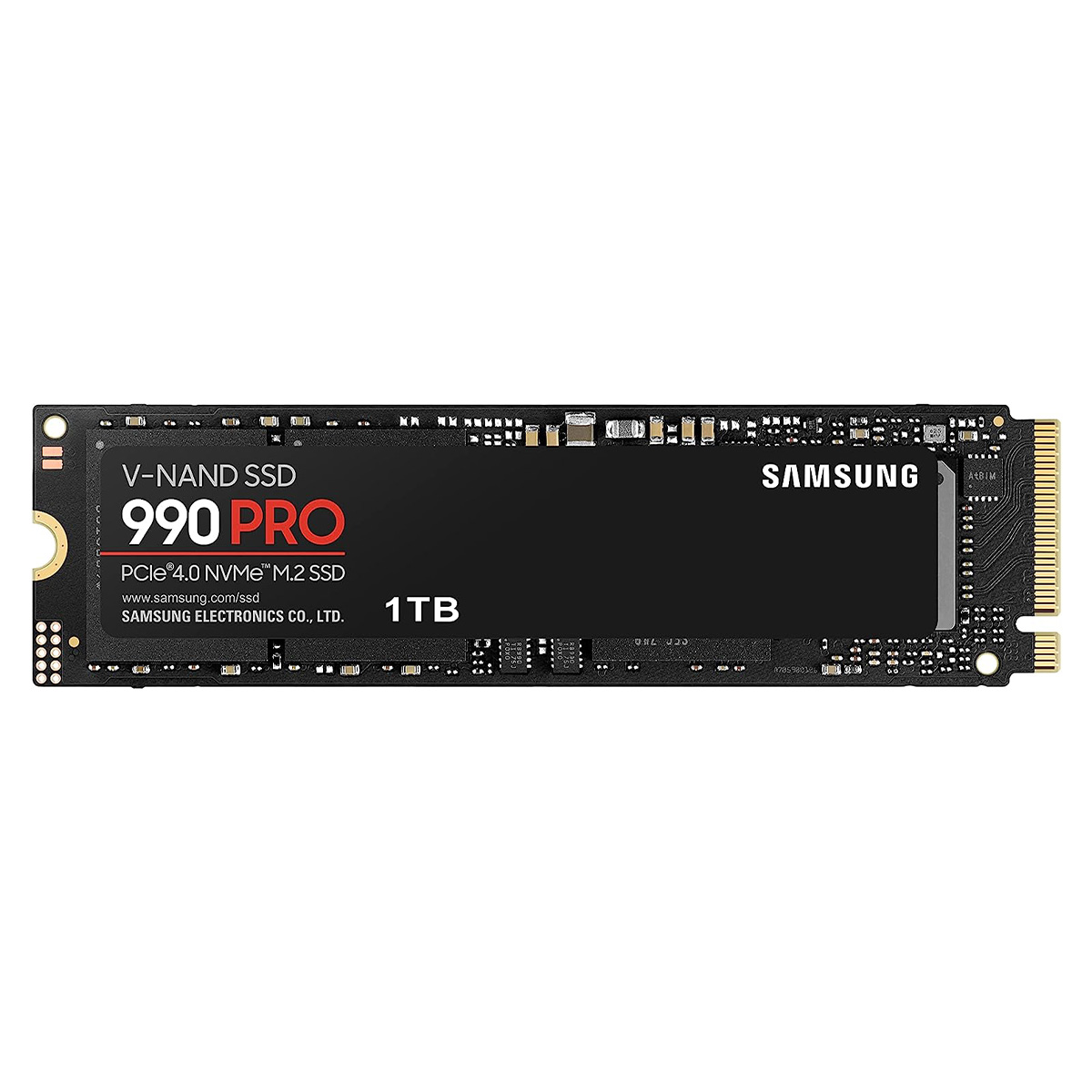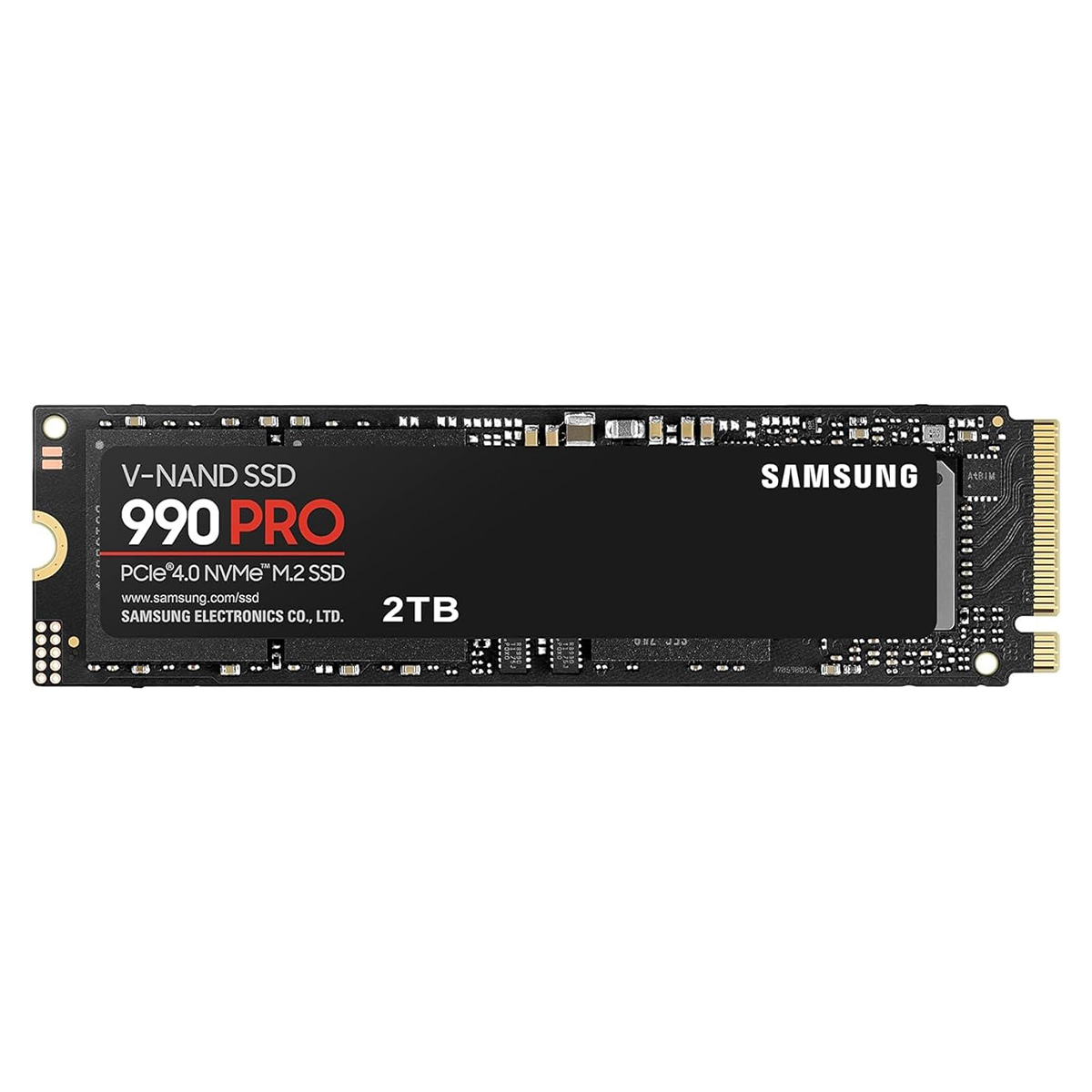Hard Drive
Hard Disk Drives (HDD) or Solid State Drives (SSD) are used for storing your data. Mainly judged for their capacity measured in GB and TB, with more being better. Seek Times, Spindle speeds, Cache size and Data Transfer Rates define how fast data is written and read from the disk. We also offer a large range of the incredibly fast Solid State Drives which are again are very reliable and several times faster than a traditional drive! And if you're wanting even more speed than a "normal" SATA based SSD, then we also offer NVME M.2 SSDs, which are considerably faster than a SATA SSD. M.2 Slots are found directly on a motherboard rather than a drive that sits in a bay and is connected via a SATA and power cable.
How much storage you need is up to you. We would generally recommend a system of 1TB and whilst there are smaller SSD drives out there at around 250GB these should ideally be paired with a larger secondary drive. Anything smaller than around 500GB is not worth having in today's market as they wont save you much money and some modern games can eat half that storage up alone!
For example;
1000 GB = 1000 x 1024 MB = 1,024,000 MB
A Single MP3 is approximately = 4 MB
Which means a 1000 GB hard drive can hold = 1,024,000 / 4 = 256,000 MP3's.
Big AAA PC games are usually between 20GB and 60GB, although there are some now that nudge the 200GB mark but thankfully these are few and far between. The average typical AAA title would be around 40GB, 1000 / 40 = A 1TB hard drive will hold around 25 PC games at any one time.
If you choose any software with your computer, then it is installed to the chosen 1st available hard drive in the drop down list. If you are choosing a SSD then we recommend you choose a SSD as your first hard drive rather than a second or third drive as this is where you would typically install an operating system - operating systems love SSD's and an operating system installed to a SSD rather than a traditional hard drive is instantly noticeable. The common configuration when incorporating a SSD is to have one as the first hard drive and usually a larger traditional second or third hard drive or if budget permits, all SSD storage. You can read more about SSDs here
2TB Seagate Barracuda 7200RPM
BarraCuda leads the industry with the highest capacities for desktops and mobile computers. Rock-solid reliability built on over 20 years of BarraCuda innovation. Versatile mix of capacity and price point options to fit any budget. Multi-Tier Caching Technology™ for excellent hard drive performance.
| Capacity | 2TB |
|---|---|
| Interface | SATAIII |
| Max Sustained Data Rate | 210MB/s |
| Cache | 64MB |
| Spindle Speed | 7200RPM |
| Average Seek Time | 8.5ms |

960GB Kingston A400 SSD
Kingston’s A400 solid-state drive dramatically improves the responsiveness of your existing system with incredible boot, loading and transfer times compared to mechanical hard drives. Powered by a latest-gen controller for read and write speeds of up to 500MB/s and 450MB/s, this SSD is 10x faster than a traditional hard drive for higher performance, ultra-responsive multi-tasking and an overall faster system.
SSD's are Faster, cooler, quieter, more reliable and uses less power than a traditional Hard Drive (HDD). Solid State Hard Drives are the future. Your system will start-up faster, applications and games will load quicker and you will see a huge improvement in overall system responsiveness.
| Capacity | 960GB |
|---|---|
| Interface | SATAIII |
| Max Sustained Data Rate | Max. Read 500MB/s, Max. Write 450MB/s |
| Average Seek Time | 0ms |

2TB Samsung 870 Evo SSD
Advanced in every way and accomplishing the maximum SATA interface limit of 560/530 MB/s sequential speeds, the 2TB Samsung 870 EVO has profoundly improved its random speed and trustworthy performance compared to its prior generation. The latest model of the world’s best-selling SSD series has finally arrived. The 870 EVO inherits the legacy of Samsung’s pioneering SSD technology, boasting upgraded performance, reliability, and compatibility to suit the needs of anyone from contents creators, IT professionals, to everyday users.
SSD's are Faster, cooler, quieter, more reliable and uses less power than a traditional Hard Drive (HDD). Solid State Hard Drives are the future. Your system will start-up faster, applications and games will load quicker and you will see a huge improvement in overall system responsiveness.
| Capacity | 2TB |
|---|---|
| Interface | SATAIII |
| Max Sustained Data Rate | Max. Read 560MB/s Max. Write 530MB/s |
| Average Seek Time | 0ms |

4TB Samsung 870 Evo SSD
Advanced in every way and accomplishing the maximum SATA interface limit of 560/530 MB/s sequential speeds, the 4TB Samsung 870 EVO has profoundly improved its random speed and trustworthy performance compared to its prior generation. The latest model of the world’s best-selling SSD series has finally arrived. The 870 EVO inherits the legacy of Samsung’s pioneering SSD technology, boasting upgraded performance, reliability, and compatibility to suit the needs of anyone from contents creators, IT professionals, to everyday users.
SSD's are Faster, cooler, quieter, more reliable and uses less power than a traditional Hard Drive (HDD). Solid State Hard Drives are the future. Your system will start-up faster, applications and games will load quicker and you will see a huge improvement in overall system responsiveness.
| Capacity | 4TB |
|---|---|
| Interface | SATAIII |
| Max Sustained Data Rate | Max. Read 560MB/s Max. Write 530MB/s |
| Average Seek Time | 0ms |

1TB Kingston NV2 M.2 PCIe 4.0 NVME SSD
Kingston’s NV2 PCIe 4.0 NVMe SSD is a substantial next-gen storage solution powered by a Gen 4x4 NVMe controller. NV2 delivers read/write speeds of up to 3,500/2,100MB/s with lower power requirements and lower heat to help optimise your system’s performance and deliver value without sacrifice. The compact single-sided M.2 2280 (22x80mm) design expands storage by up to 4TB while saving space for other components, making NV2 ideal for thinner notebooks, small-form-factor (SFF) systems and DIY motherboards.
| Capacity | 1TB |
|---|---|
| Interface | M.2 NVMe PCIe 4.0 |
| Max Sustained Data Rate | Max. Read 3,500MB/s Max. Write 2,100MB/s |
| Average Seek Time | 0ms |

2TB Kingston NV2 M.2 PCIe 4.0 NVME SSD
Kingston’s NV2 PCIe 4.0 NVMe SSD is a substantial next-gen storage solution powered by a Gen 4x4 NVMe controller. NV2 delivers read/write speeds of up to 3,500/2,800MB/s with lower power requirements and lower heat to help optimise your system’s performance and deliver value without sacrifice. The compact single-sided M.2 2280 (22x80mm) design expands storage by up to 4TB while saving space for other components, making NV2 ideal for thinner notebooks, small-form-factor (SFF) systems and DIY motherboards.
| Capacity | 2TB |
|---|---|
| Interface | M.2 NVMe PCIe 4.0 |
| Max Sustained Data Rate | Max. Read 3,500MB/s Max. Write 2,800MB/s |
| Average Seek Time | 0ms |

4TB Kingston NV2 M.2 PCIe 4.0 NVME SSD
Kingston’s NV2 PCIe 4.0 NVMe SSD is a substantial next-gen storage solution powered by a Gen 4x4 NVMe controller. NV2 delivers read/write speeds of up to 3,500/2,800MB/s with lower power requirements and lower heat to help optimise your system’s performance and deliver value without sacrifice. The compact single-sided M.2 2280 (22x80mm) design expands storage by up to 4TB while saving space for other components, making NV2 ideal for thinner notebooks, small-form-factor (SFF) systems and DIY motherboards.
| Capacity | 4TB |
|---|---|
| Interface | M.2 NVMe PCIe 4.0 |
| Max Sustained Data Rate | Max. Read 3500MB/s Max. Write 2800MB/s |
| Average Seek Time | 0ms |

1TB Samsung 990 PRO M.2 PCIe 4.0 NVME SSD
Release the potential of the Samsung SSD 990 PRO, Samsung’s first consumer PCIe 4.0 NVMe SSD, for superior computing experiences. Designed for graphics-intensive games and heavy-duty applications, the 990 PRO leverages Samsung’s custom controller and PCIe 4.0 to provide double the data transfer rate of PCIe 3.0.
SSDs are Faster, cooler, quieter, more reliable and uses less power than a traditional Hard Drive (HDD). Solid State Hard Drives are the future. Your system will start-up faster, applications and games will load quicker and you will see a huge improvement in overall system responsiveness. Now in M.2 NVME Interface for many times the performance of a SATA SSD!
| Capacity | 1TB |
|---|---|
| Interface | PCIe 4.0 M.2 NVMe |
| Max Sustained Data Rate | Max. Read 7,450MB/s Max. Write 6,900MB/s |
| Average Seek Time | 0ms |

2TB Samsung 990 PRO M.2 PCI 4.0 NVME SSD
Release the potential of the Samsung SSD 990 PRO, Samsung’s first consumer PCIe 4.0 NVMe SSD, for superior computing experiences. Designed for graphics-intensive games and heavy-duty applications, the 990 PRO leverages Samsung’s custom controller and PCIe 4.0 to provide double the data transfer rate of PCIe 3.0.
SSDs are Faster, cooler, quieter, more reliable and uses less power than a traditional Hard Drive (HDD). Solid State Hard Drives are the future. Your system will start-up faster, applications and games will load quicker and you will see a huge improvement in overall system responsiveness. Now in M.2 NVME Interface for many times the performance of a SATA SSD!
| Capacity | 2TB |
|---|---|
| Interface | PCI 4.0 M.2 NVMe |
| Max Sustained Data Rate | Max. Read 7,450MB/s Max. Write 6,900MB/s |
| Average Seek Time | 0ms |

4TB Samsung 990 PRO M.2 PCIe 4.0 NVME SSD
Release the potential of the Samsung SSD 990 PRO, Samsung’s first consumer PCIe 4.0 NVMe SSD, for superior computing experiences. Designed for graphics-intensive games and heavy-duty applications, the 990 PRO leverages Samsung’s custom controller and PCIe 4.0 to provide double the data transfer rate of PCIe 3.0.
SSDs are Faster, cooler, quieter, more reliable and uses less power than a traditional Hard Drive (HDD). Solid State Hard Drives are the future. Your system will start-up faster, applications and games will load quicker and you will see a huge improvement in overall system responsiveness. Now in M.2 NVME Interface for many times the performance of a SATA SSD!
| Capacity | 4TB |
|---|---|
| Interface | PCI 4.0 M.2 NVMe |
| Max Sustained Data Rate | Max. Read 7,450MB/s Max. Write 6,900MB/s |
| Average Seek Time | 0ms |
